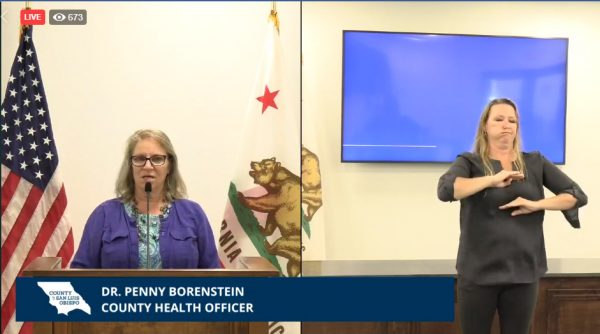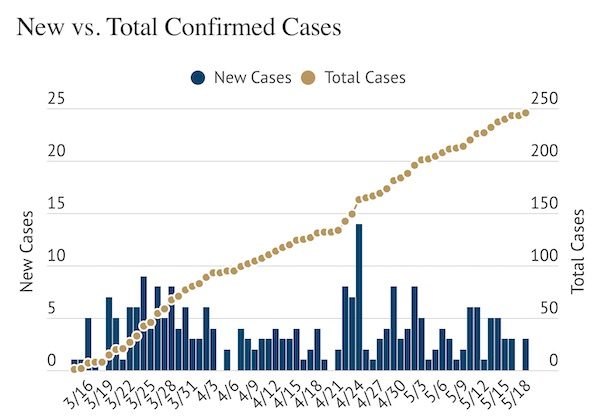COVID-19: SLO County ready for California’s new Stage 2 variance criteria
Retailers and restaurants should prepare to open, county says
–The County of San Luis Obispo will re-attest it is ready to reopen certain segments of the community given new Stage 2 criteria from the State of California.
On Sunday, the state provided county officials with two specific criteria for ensuring low or stable hospitalization rates and the rate of positive COVID-19 cases per 100,000 population.
“It’s clear that the state heard us,” said Dr. Penny Borenstein, SLO County Health Officer. “The state issued two new criteria that are better indicators of current transmission trends, and both of those criteria work in our favor.”
A county that has met certain state criteria in containing COVID-19 can increase the pace at which they advance through Stage 2 of California’s Resilience Roadmap for reopening. As of this morning, 23 counties meet the state’s criteria to move faster through Stage 2. Dr. Borenstein says San Luis Obispo County meets the new criteria and plans to fill out a new state form attesting to the county’s readiness to reopen.
In Monday’s briefing, Borenstein announced how the county meets the new criteria:
- The state criteria is: 20 hospitalized cases in two weeks. San Luis Obispo County has had six hospitalizations in the past two weeks and only two remain in the hospital.
- The state’s criteria for new cases of COVID-19 is 2.5 per 1000 population. There have been 1.5 new cases in the county per 1000 population.
“This week, we will again attest to the state that we are ready to adapt and reopen under this new criteria,” Dr. Borenstein said. “This means that we should soon get approval to move forward with in-store retail shopping and dine-in restaurants. Retailers and restaurants should prepare now by reviewing state-required public health precautions for their industry.”
The SLO County Board of Supervisors will review the new attestation on May 19 and then Dr. Borenstein will submit it to the state for review. It is unclear when the state will make a determination, but county officials believe it will be this week.
Local businesses can find state criteria for reopening based on their specific industry by visiting emergencySLO.org/reopen.
 Three cases added Monday
Three cases added Monday
The County of San Luis Obispo now has 246 total reported cases of COVID-19 as of Monday afternoon, adding three cases since Sunday. 207 people have recovered from the virus, six more than Sunday. 36 are currently recovering at home, two are hospitalized with two in the ICU. One person has died from the virus. Click here to see detailed case statistics.
From the California Department of Public Health:
California Department of Public Health announces new regional variance opportunity
–Given increased statewide and local capacity to respond to COVID-19, including stronger preparedness, continued stability in the number of COVID-19 hospitalizations, as well as increased ability to provide personal protective equipment to workers in essential sectors, the California Department of Public Health announced Monday a new attestation opportunity for counties to move through Stage 2, opening additional sectors of their economy at their own pace. To qualify, counties must attest that hospitalization and test positivity rates are stable or declining; that they have a significant level of preparedness with testing, contact tracing, PPE, and hospital surge; and that they have adequate plans related to county-wide containment.
The department also announced that starting Monday, some sectors of the economy statewide can begin reopening with modifications, including office spaces and counseling services in places of worship, curbside libraries, and drive-in movie theaters.
“Californians have done incredible work flattening the curve and slowing the spread of COVID-19,” said Governor Newsom. “As we seek an effective therapeutic or vaccine, we are moving into a new chapter in the fight against the disease – focusing on protecting public health by lowering the risk of transmission and aggressively moving to protect vulnerable communities. The virus will still be present in our communities, and it’s as important as ever for Californians to take steps to protect themselves and their families. Wash your hands. Keep physical distance. If you have an underlying health condition that makes you more vulnerable to COVID-19, you should still stay home.”
California began its regional variance process on May 7. Allowing this initial approach to move forward for approximately 10-14 days allowed the state and counties to see the early impact of these modifications to the statewide Stay-at-Home order. Anticipating the need and appropriateness of allowing additional counties to control the focus of restrictions for their own jurisdictions, state public health leaders are now creating opportunities for additional counties to assume more local control in Stage 2 and improve local level preparedness.
The state outlined a new process that will be similar to the first variance process allowing for prepared counties to advance at their own pace through Stage 2. To qualify, a county must attest to:
Case Metrics: Stable or down trending hospitalizations, cases per population count and test positivity rate. This includes:
- Stable hospitalizations on a 7-day average of daily percent change of less than 5-percent; or no more than 20 hospitalizations on any single day over the past 14 days.
- 14-day cumulative positive incidence of less than 25 per 100,000; or testing positivity over the past 7 days of less than 8-percent.
Adequate Preparedness Planning: A significant level of preparedness with testing, contact tracing, PPE and hospital surge, and planning for long-term care facility disease outbreak prevention and containment. This includes:
- Testing capacity: Minimum daily testing capacity to test 1.5 per 1,000 residents, and testing availability for at least 75% of residents
- Contact tracing: At least 15 staff per 100,000 county population trained and available for contact tracing
- Hospital surge: Hospital capacity to accommodate a minimum surge of 35% of their baseline average daily census.
- Skilled Nursing Facilities (SNF) disease outbreak prevention and containment plans to prevent and mitigate infections in skilled nursing facilities, and that SNFs have more than 14-day supply of PPE on hand for staff, with an established process for ongoing procurement.
- Response Planning: Producing plans related to county-wide containment, including testing, contact tracing, vulnerable populations, congregate settings, acute care surge, and essential workforce.
- Follow all Paso Robles COVID-19 coronavirus news updates
- San Luis Obispo County COVID-19 website – readyslo.org
Comments
The news staff of the Paso Robles Daily News wrote or edited this story from local contributors and press releases. The news staff can be reached at info@pasoroblesdailynews.com.



 Three cases added Monday
Three cases added Monday
















